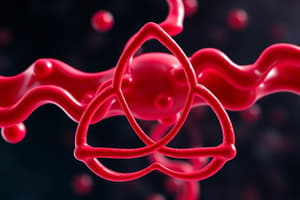Podcast
Questions and Answers
According to Virchow's Triad, which factor contributes to the etiology of deep vein thrombosis (DVT)?
According to Virchow's Triad, which factor contributes to the etiology of deep vein thrombosis (DVT)?
- Increased blood pressure
- Venous stasis (correct)
- Decreased platelet count
- Arterial dilation
Which clinical manifestation is commonly associated with deep vein thrombosis (DVT)?
Which clinical manifestation is commonly associated with deep vein thrombosis (DVT)?
- Decreased skin temperature
- Absence of pain
- Unilateral leg edema (correct)
- Bilateral leg edema
What is the primary mechanism of action of heparin?
What is the primary mechanism of action of heparin?
- Directly dissolving existing clots
- Activating antithrombin to prevent clot formation (correct)
- Inhibiting platelet aggregation
- Blocking vitamin K synthesis
Which route of administration is appropriate for enoxaparin (Lovenox)?
Which route of administration is appropriate for enoxaparin (Lovenox)?
A patient is prescribed warfarin. What laboratory value is essential to monitor for therapeutic effect?
A patient is prescribed warfarin. What laboratory value is essential to monitor for therapeutic effect?
What is a major adverse effect to monitor in a patient receiving thrombolytic drugs?
What is a major adverse effect to monitor in a patient receiving thrombolytic drugs?
Which statement accurately describes the mechanism of action of direct thrombin inhibitors?
Which statement accurately describes the mechanism of action of direct thrombin inhibitors?
Which of the following instructions is most important to include in the patient education for someone starting anticoagulant therapy?
Which of the following instructions is most important to include in the patient education for someone starting anticoagulant therapy?
A patient with a history of heparin-induced thrombocytopenia (HIT) requires anticoagulation. Which of the following agents is LEAST appropriate for this patient?
A patient with a history of heparin-induced thrombocytopenia (HIT) requires anticoagulation. Which of the following agents is LEAST appropriate for this patient?
A patient receiving warfarin develops a supratherapeutic INR of 9.0 and is actively bleeding. Beyond immediate discontinuation of warfarin, what is the MOST appropriate initial intervention?
A patient receiving warfarin develops a supratherapeutic INR of 9.0 and is actively bleeding. Beyond immediate discontinuation of warfarin, what is the MOST appropriate initial intervention?
Flashcards
Deep Vein Thrombosis (DVT)
Deep Vein Thrombosis (DVT)
Formation of a thrombus in association with inflammation of a vein, commonly in the iliac or femoral veins.
Pulmonary Embolus (PE)
Pulmonary Embolus (PE)
Blood clot that detaches and moves to the Pulmonary artery which can block blood flow to the lungs.
Venous stasis
Venous stasis
A condition where the valves are dysfunctional and Muscles in extremities are inactive which increase the risk for DVT.
Damage to the Endothelium
Damage to the Endothelium
Signup and view all the flashcards
Hypercoagulability
Hypercoagulability
Signup and view all the flashcards
Risk factors for DVT
Risk factors for DVT
Signup and view all the flashcards
Pathophysiology of DVT
Pathophysiology of DVT
Signup and view all the flashcards
Clinical Manifestations of DVT
Clinical Manifestations of DVT
Signup and view all the flashcards
Coagulation Modifier Drugs
Coagulation Modifier Drugs
Signup and view all the flashcards
Parenteral Anticoagulant: Heparin
Parenteral Anticoagulant: Heparin
Signup and view all the flashcards
Study Notes
Deep Vein Thrombosis (DVT)
- DVT involves the formation of a thrombus alongside vein inflammation.
- Superficial vein thrombosis features a thrombus in superficial veins, typically in the extremities.
- Deep vein thrombosis involves a thrombus in a deep vein, usually in the iliac or femoral veins.
- Venous thromboembolism occurs when a DVT detaches, moves to the pulmonary artery, and causes a pulmonary embolus.
Etiology of DVT - Virchow's Triad
- Venous stasis can be caused by dysfunctional valves, inactivity of extremity muscles, obesity, pregnancy, post-operative states, and immobility.
- Damage to the endothelium can be direct via fracture, surgery, or trauma, or indirect via chemotherapy or diabetes.
- Hypercoagulability of the blood can be caused by hematologic disorders, anemias, malignancies, or clotting/protein deficiencies.
Risk Factors for DVT
- Risk factors include pregnancy, oral contraceptives, post-menopausal therapy (SERMS), hormone replacement therapy, post-chemotherapy/hysterectomy, and tobacco use.
Pathophysiology of DVT
- Platelet aggregation and fibrin entrap red blood cells (RBCs), white blood cells (WBCs), and platelets, forming a thrombus.
- A thrombus enlarges as more cells adhere.
- An Embolus results if a thrombus detaches which may lead to a pulmonary embolus.
DVT: Clinical Manifestations
- Clinical manifestations include unilateral leg edema, extremity pain, fullness in the calf/thigh, erythema and warmth.
- A positive Homan's sign can be an indicator, involving pain with dorsiflexion of the foot.
DVT Complications
- A major complication of DVT is pulmonary embolism (PE), where thrombi block the pulmonary arteries.
- Emboli are mobile clots which lodge in narrow parts of the circulatory system.
- Pulmonary embolism has a 30% mortality rate.
- Pulmonary embolism can result from other causes, including atrial fibrillation and upper extremity DVT.
PE: Clinical Manifestations
- Clinical manifestations include dyspnea, chest pain, hemoptysis, cough, pleuritic chest pain, and crackles on auscultation of lungs.
Hemostasis
- Hemostasis is the general term for any process that stops bleeding.
- Coagulation is hemostasis that occurs due to physiologic clotting of blood.
- The process has a complex relationship between substances promoting clot formation and those inhibiting coagulation or dissolving formed clots.
Coagulation System
- The coagulation system follows a "Cascade" effect.
- Each activated factor acts as a catalyst that amplifies the next reaction.
- The end result is fibrin, a clot-forming substance.
- The system involves the intrinsic and extrinsic pathways.
Coagulation Modifier Drugs
- Anticoagulants, given orally or parenterally, inhibit the action or formation of clotting factors and prevent clot formation.
- Antiplatelet drugs interfere with platelet function, inhibit platelet aggregation, and prevent platelet plugs.
- Thrombolytic/Fibrinolytic drugs break down existing clots.
- Other modifiers include direct thrombin inhibitors and direct inhibitors of Factor XA.
Parenteral Anticoagulants (Heparin)
- Heparin prevents clotting by activating antithrombin, inhibiting thrombin, and working on different points of the clotting cascade.
- It is used prophylactically to prevent clot formation (thrombus) and emboli (dislodged clot).
- Heparin is used in emergency conditions requiring prompt therapy (Stroke, DVT, PE) and disseminated intravascular coagulation.
- Also used preventatively for stroke, MI, DVT, and PE.
- Adverse reactions of Heparin include hemorrhage, heparin-induced thrombocytopenia, hypersensitivity reactions, and toxicity.
- Heparin is administered subcutaneously (SQ) or intravenously (IV).
Parenteral Anticoagulants (Heparin) Nursing Administration
- For intravenous heparin, obtain baseline vitals and labs (CBC, PLT, HCT).
- Obtain APTT (Activated Partial Thromboplastin Time) every 4-6 hours until stable levels, maintaining a therapeutic APTT of 1.5-2.5 times normal.
- Read label, double-check dose with a second nurse, and administer Heparin through an infusion pump only.
- Protamine Sulfate is the antidote for Heparin.
- For subcutaneous heparin, use a 25-28 gauge needle of 1/2-5/8 inches.
- Injections should be placed in the abdomen at least 2 inches away from the umbilicus.
- Aspiration is not required, and gentle pressure should be applied to the injection site for 1-2 minutes, rotating sites.
Parenteral Anticoagulants: enoxaparin (Lovenox)
- Enoxaparin is a low molecular weight heparin (LMWH) that primarily acts on coagulation factor Xa, limiting thrombin generation needed for fibrin production.
- Used to prevent DVT in post-op patients, prevent complications from certain types of MI, and to treat DVT/PE.
- Route of administration is subcutaneous (SQ) only.
- Adverse effects include hemorrhage, neurologic damage from hematoma formation in those receiving spinal or epidural anesthesia, and thrombocytopenia.
- Administered with pre-filled syringes without expelling the air bubble, injecting in the abdomen (without aspiration), rotating sites, and monitoring for bleeding.
- Antidote is Protamine Sulfate.
Oral Anticoagulants: warfarin sodium (Coumadin)
- Warfarin antagonizes Vitamin K, preventing the synthesis of additional coagulation factors.
- It is used for treatment of DVT, prevention of clots in those with AFIB and prosthetic valves, and prevention of transient ischemic attacks (TIA), PE, and DVT.
- Route of administration is oral only.
- Monitored by prothrombin time (PT) and international normalized ratio (INR), with PT-INR being the monitored value.
- Vitamin K is the antidote.
- Requires long-term outpatient therapy.
- Therapy dosages can vary; for example, 5mg PO daily on Monday, Wednesday, Friday, and Sunday, and 2.5mg PO daily on Tuesday, Thursday, and Saturday.
Warfarin Sodium: Nursing Implications
- Warfarin therapy should begin while the patient is still on heparin until PT-INR levels indicate adequate anticoagulation.
- The full therapeutic effect takes several days.
- PT-INR should be monitored regularly with follow-up appointments.
- The therapeutic PT-INR should be 2-3 times the normal value.
- Herbal products can lead to increased bleeding when interacted with, including capsicum pepper, garlic, ginger, ginkgo, St. John's wort, and feverfew.
Direct Thrombin Inhibitors: dabigatran (Pradaxa)
- Dabigatran acts directly by inhibiting thrombin, preventing thrombus development.
- It is used to prevent stroke or embolism in patients with afib not caused by valvular heart disease.
- Route of administration is oral (should not be crushed); can be taken with or without food; discontinue other anticoagulants when starting dabigatran.
- Adverse effects include bleeding and GI discomfort.
Direct Inhibitor of Factor XA: rivaroxaban (Xarelto)
- Rivaroxaban acts through anticoagulation by inhibiting Factor Xa.
- It is used to prevent DVT and PE in clients undergoing total hip or knee/arthroplasty.
- Administer tablets orally once a day, with or without food at the same time every day.
- Monitor Hgb, HCT, and liver and kidney function during treatment.
- Adverse effects include bleeding and elevated liver enzymes.
Anticoagulants: Patient Education
- Patient education should include the importance of regular lab testing, signs of abnormal bleeding, measures to prevent bruising/bleeding/tissue injury, and wearing a medical alert bracelet.
- Patients should avoid foods high in vitamin K and consult the physician before taking other meds or over-the-counter products, including herbals.
Antiplatelet Drugs
- Antiplatelet drugs prevent platelet adhesion, reduce the risk of fatal and nonfatal strokes, and address acute unstable angina and MI.
- Adverse effects include bleeding.
- Aspirin is cardio-protective, available in PO and suppository forms, and comes in 81mg or 325mg dosages.
- Clopidogrel (Plavix) is often used in patients with stents and is taken at 75mg PO daily.
- Antiplatelet/glycoprotein inhibitors like eptifibatide (Integrilin) are usually administered in the ICU or cardiac cath lab.
- Adverse effects of eptifibatide medications include bleeding, hypotension, and bradycardia.
Thrombolytic Drugs/Fibrinolytics
- Thrombolytic drugs break down or lyse pre-formed clots and are also known as "Clot busters".
- Indications include DVT, pulmonary embolus, and occlusion of shunts or catheters.
- They are used in the treatment of acute MI, which requires initiation within 6 hours of symptom onset, and for acute ischemic stroke, with must be initiated within 3 hours of onset.
- Examples include anistreplase (Eminase), alteplase (t-PA, Activase), reteplase (Retavase), and tenecteplase (TNKase).
Thrombolytic Drugs/Fibrinolytics: Mechanism of Action
- These function to activate the fibrinolytic system and break down any clots inside blood vessels quickly.
- Activate plasminogen and convert it to plasmin, which can digest fibrin.
- The drugs reestablish blood flow to the affected area, such as to the lungs via the pulmonary artery and the heart muscle via the coronary arteries, preventing tissue destruction.
- Adverse effects include bleeding (internal, intracranial, superficial) and other effects, such as nausea and vomiting, hypotension, anaphylactic reactions, and cardiac dysrhythmias.
Thrombolytic Drugs: Nursing Implications
- Nursing implications include following strict manufacturer's guidelines for preparation and administration, monitoring the IV site for bleeding/redness/pain, and monitoring for bleeding from gums, mucous membranes, nose, and injection sites.
- Signs of internal bleeding (decreased BP restlessness increased pulse) should be observed, as well as monitoring for changes in mental status.
Coagulation Modifier Drugs: Nursing Implications
- Monitor for therapeutic effects and for signs of excessive bleeding.
- Signs of excessive bleeding include bleeding of gums while brushing teeth, unexplained nosebleeds, heavier menstrual bleeding, bloody or dark stools, bloody urine or sputum, abdominal pain and vomiting blood.
Studying That Suits You
Use AI to generate personalized quizzes and flashcards to suit your learning preferences.




